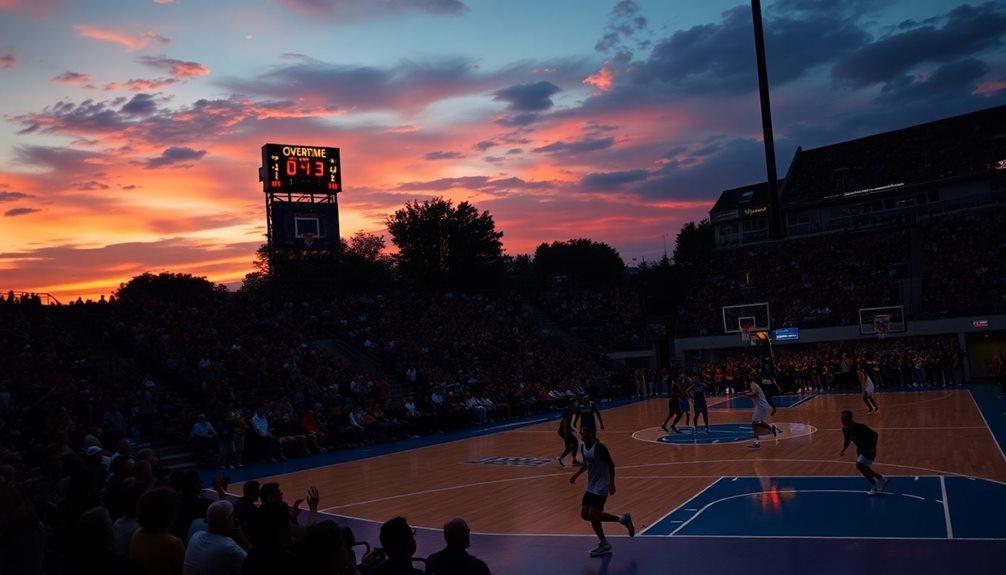
How Long Are Basketball Games? Breaking Down the Duration
December 12, 2024Basketball games usually last between 40 to 48 minutes, depending on the league. For instance, the NBA has four 12-minute quarters, while the WNBA and NCAA use halves or shorter quarters. However, the actual time can extend to about 2.5 to 3 hours due to timeouts, halftime breaks, and stoppages in play. Overtime periods can also add to the duration, typically lasting 5 minutes. Factors like injuries and referees' reviews can further influence game time. If you're curious about the specifics of each league's format, you might find some interesting details ahead.
Game Lengths Across Leagues
When you tune into a basketball game, you'll notice that the length can vary considerably depending on the league. The NBA stands out with its structure of four 12-minute quarters, totaling 48 minutes of game time. In contrast, WNBA games are played in two 20-minute halves, resulting in a shorter total of 40 minutes.
The evolution of sports, including basketball, has parallels with other games, such as the historical significance of the establishment of the Football Association, which standardized rules and shaped competitive play.
If you're watching NCAA basketball, you'll see some differences as well. NCAA Men's games consist of two 20-minute halves, while NCAA Women's games are divided into four 10-minute quarters, also equating to 40 minutes.
FIBA games follow a similar format to the WNBA, using four 10-minute quarters for a total of 40 minutes of playtime. When it comes to youth basketball, game lengths can vary even more, typically ranging from 32 to 40 minutes. Depending on the age group and league regulations, you might find games using either 8-minute or 10-minute quarters.
With these varying formats, understanding game lengths across leagues can enhance your viewing experience, whether you're at a professional NBA game or cheering on a youth basketball team.
Factors Affecting Game Duration
Have you ever wondered why a basketball game takes much longer than the actual playing time? While NBA games are structured to last 48 minutes, various factors can extend the game duration to around 2.5 hours.
The use of data analytics and technology in basketball has also influenced how teams manage timeouts and strategies during these pauses, enhancing gameplay efficiency and decision-making on the court, leading to impactful strategies that can affect game flow.
Here are some key elements that contribute to this:
- Timeouts: Each team can call up to seven timeouts, each lasting 75 seconds.
- Halftime Breaks: The 15-minute halftime allows players to regroup, adding to the total time.
- Overtime Periods: If the score is tied, overtime periods of 5 minutes can greatly increase game time.
- Stoppages: Referee reviews, injuries, and fouls frequently stop the game clock, prolonging the viewing experience.
These factors combined lead to increased stoppages and interruptions, making the game's actual playtime feel brief in comparison.
As you watch an NBA game, you'll notice how these elements contribute to the overall excitement and pacing, even if they stretch the game duration beyond what you might expect.
Understanding these components helps you appreciate the strategic pauses and intense moments that define basketball's thrilling nature.
Overtime Rules and Records

Basketball's excitement often extends beyond regulation time, especially when teams are neck-and-neck. Overtime periods in basketball generally last 5 minutes across most leagues, including the NBA, WNBA, and NCAA. When a game goes into overtime, the NBA allows each team one additional timeout, while both the NCAA and WNBA also permit added timeouts to strategize.
This heightened intensity often leads to strategic adjustments, as teams may employ evolving defensive strategies to counter their opponents' late-game tactics.
Records reveal some thrilling moments in overtime history. The longest NBA game on record lasted a staggering 78 minutes, with six overtime periods played on January 6, 1951. The Indianapolis Olympians triumphed over the Rochester Royals in a true test of endurance.
In the WNBA, the longest game took place in June 2002, lasting 2 hours and 57 minutes, featuring three overtime periods where the Orlando Miracle defeated the Cleveland Rockers.
The NCAA boasts its own record with a remarkable 7-overtime match in 1981, totaling 75 minutes of play between Bradley and Cincinnati. These extreme durations challenge players and create unforgettable basketball games that fans will remember for years.
Fan Engagement Opportunities
Fans' experiences at basketball games are elevated through various engagement opportunities that occur during game stoppages. These moments, such as timeouts and halftime breaks, create the perfect environment for fun activities that not only entertain but also boost attendance and revenue.
Engaging with families and fostering community connections during these breaks can enhance the overall atmosphere of the game, similar to how soccer fans come together to support their teams through shared experiences strengthens community bonds.
Here are some fan engagement highlights:
- Sponsored Contests: Teams often host contests during timeouts, where fans can win prizes by participating in quick challenges.
- In-Game Promotions: Half-court shot contests and prize airdrops during stoppages keep the excitement alive and encourage fan interaction.
- Cheerleader and Mascot Performances: Live entertainment during halftime breaks captivates the crowd and enhances the overall game experience.
- Promotional Giveaways: Teams frequently use halftime to distribute merchandise or tickets, increasing fan loyalty and viewership.
With the typical NBA game featuring seven timeouts per team, these breaks can extend the overall game duration by over 15 minutes. This time allows franchises to leverage fan engagement opportunities effectively, making basketball games not just about the sport, but also about creating lasting memories for fans.
Game Scheduling and Regulations

When you watch basketball, you'll notice different game formats across leagues, like the NBA's four 12-minute quarters versus the NCAA's two 20-minute halves.
This variation reflects the growing global basketball landscape, where global basketball expansion is evident through diverse international leagues and tournaments.
Overtime can also shake things up, adding five more minutes if teams are tied after regulation.
Plus, scheduling strategies and regulations around timeouts and halftimes can really affect how long you need to plan for a game.
Game Format Differences
Typically, basketball games vary in format depending on the league and level of play, influencing how long they last. Here's a quick overview of some key differences:
- NBA: Four 12-minute quarters totaling 48 minutes.
- NCAA Men's: Two 20-minute halves, resulting in a 40-minute game duration.
- WNBA: Similar to NCAA men's, it features two 20-minute halves, also totaling 40 minutes.
- FIBA: Games are structured in four 10-minute quarters, adding up to 40 minutes, aligning with NCAA women's games.
Youth basketball has even more variability, typically ranging from 32 to 40 minutes, with formats like eight-minute or ten-minute quarters.
While the standard game duration can differ, overtime periods in leagues like the NBA, NCAA, and WNBA last 5 minutes when necessary, which can extend the total game duration.
Understanding these game format differences helps you appreciate the unique pacing and structure of basketball games across various levels, from youth basketball to professional leagues like the NBA and WNBA.
Overtime Impact
Overtime in basketball can profoundly alter game scheduling and regulations, impacting how long you can expect a game to last. In leagues like the NBA and NCAA, overtime periods last 5 minutes, giving teams a chance to secure a win when tied at the end of regulation. However, this can considerably extend the game length.
For instance, NBA overtime games often push total game time to around 3 hours, especially with stoppages and timeouts factored in. Each team gets one additional timeout during overtime, which can change game strategy as coaches and players manage their resources in critical moments.
The pressure of extended play can lead to intense scenarios, particularly in high-stakes playoff games where multiple overtime periods might occur. Historical records show that the longest NBA game in 1951 lasted 78 minutes due to six overtime periods, highlighting how unpredictable the duration can be.
Being prepared for the possibility of overtime is essential, as it can greatly influence the pacing and outcome of the game. So, when you're planning to catch a game, keep in mind that overtime could surprise you with both excitement and extended viewing time.
Scheduling Strategies
Basketball leagues prioritize effective scheduling strategies to enhance fan engagement and optimize game times. By thoughtfully planning, they can increase viewership and attendance while adhering to game regulations.
Here are four key factors that influence scheduling:
- Game Duration: Understanding the overall time needed for basketball games, including stoppages, can help in scheduling.
- Timeouts Per Quarter: Each league has its own rules for timeouts within the game. For example, the NBA allows seven timeouts, impacting game flow and duration.
- Halftime Break: Typically lasting 15 minutes in professional leagues, this break is essential for teams to regroup and strategize.
- Shot Clock Rules: Different leagues employ varying shot clock rules, with the NBA and FIBA using a 24-second clock, while NCAA basketball opts for 30 seconds, affecting game pacing.
These scheduling strategies not only optimize game times but also guarantee a seamless experience for fans.
Key Takeaways on Game Duration
When you watch basketball, it's essential to know that game lengths vary by league. NBA games last 48 minutes, while WNBA and NCAA games total 40 minutes, but stoppages can extend that time considerably.
Additionally, the influence of notable figures like Bill Russell's Record-Breaking 11 Championships highlights the importance of understanding the historical context of the game.
Understanding these differences and the factors that influence duration can help you plan your viewing experience.
League-Specific Game Lengths
Game durations vary greatly across different leagues, impacting how fans experience the sport. Understanding these differences can enhance your appreciation of the game. Here's a quick breakdown of game lengths across major leagues:
- NBA: 48 minutes, divided into four 12-minute quarters.
- WNBA: 40 minutes, played in two 20-minute halves.
- NCAA Men's Basketball: 40 minutes, structured with two 20-minute halves.
- NCAA Women's Basketball: 40 minutes, consisting of four 10-minute quarters.
FIBA games also last 40 minutes, featuring four 10-minute quarters. Youth basketball games typically range from 32 to 40 minutes, often using either 8 or 10-minute quarters.
These variations in game length can influence your viewing experience, as the pacing and strategy may shift between leagues. For instance, the NBA's longer quarters allow for different gameplay dynamics compared to the WNBA's halves or the NCAA's structure.
Whether you're watching a professional game or cheering for a youth basketball team, knowing the duration helps you better anticipate the flow of the game. So next time you tune in, you'll be well-informed on what to expect!
Factors Influencing Duration
Several factors influence the overall duration of basketball games, making them longer than their official time on the clock. While NBA games are structured to last 48 minutes, the game duration typically stretches to about 2.5 hours.
Stoppages for fouls, timeouts, and injuries greatly contribute to this extended timeframe. Each team is allowed seven timeouts, which can add over 15 minutes to the total game duration, disrupting the flow of play.
Halftime breaks also play a role, lasting 15 minutes and ensuring fans have time to recharge.
If the game reaches overtime, which lasts five minutes, it can further extend the overall time, especially if the teams are tied at the end of regulation.
Additionally, stoppages for free throws and assessments of injured players can prolong the viewing experience, affecting the overall duration of basketball games.
Conclusion
In the world of basketball, games can feel like a thrilling sprint or an intense marathon, depending on the league and circumstances. While the clock ticks down in regulation, the excitement can surge during overtime, keeping you on the edge of your seat. Whether you're catching a quick game or settling in for a nail-biter, understanding the nuances of game duration enhances your experience. So, next time you watch, appreciate both the rhythm and the unpredictability of the game.


